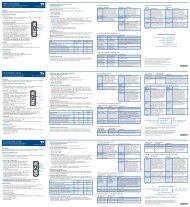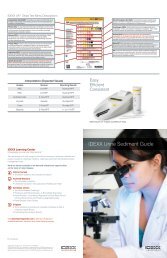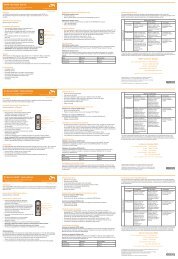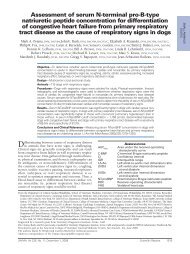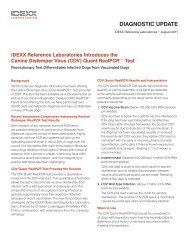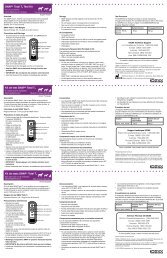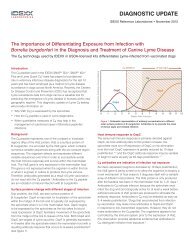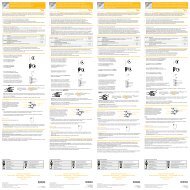New Tests for Pancreatitis - IDEXX Laboratories
New Tests for Pancreatitis - IDEXX Laboratories
New Tests for Pancreatitis - IDEXX Laboratories
Create successful ePaper yourself
Turn your PDF publications into a flip-book with our unique Google optimized e-Paper software.
<strong>New</strong> <strong>Tests</strong> <strong>for</strong> <strong>Pancreatitis</strong>Jörg Steiner,MedVet, DrMedVet,PhD, DiplomateACVIM & ECVIM(Companion Animal),Texas A&M UniversityReprinted from theApril 2010 issue ofNAVC Clinician’s Brief ®
DiagnosticsGASTROENTEROLOGYJörg Steiner, MedVet, DrMedVet, PhD,Diplomate ACVIM & ECVIM (Companion Animal),Texas A&M University<strong>New</strong> <strong>Tests</strong> <strong>for</strong> <strong>Pancreatitis</strong>Recent studies suggest thatpancreatitis is far morecommon in dogs and catsthan previously believed.Some patients, especially dogs, have clinicalsigns, such as vomiting and abdominal pain,which are classically associated with acutepancreatitis. However, other patients have lesspronounced clinical pictures or even subclinicaldisease. Diagnostic tests are crucial to determiningthe correct diagnosis.Many tests have been evaluated <strong>for</strong> diagnosis ofpancreatitis in small animal patients and are discussedin detail elsewhere. 1 This discussion willfocus exclusively on Spec cPL, SNAP cPL, andSpec fPL (idexx.com); this set of diagnostic testsbecame available over the last 2 years. Whilethese are the most sensitive and specific testsavailable <strong>for</strong> diagnosis of pancreatitis in dogs andcats, sound medical judgment and evaluation ofall available data allow a practitioner to make anaccurate diagnosis.PANCREATIC LIPASE IMMUNOREACTIVITYAssays <strong>for</strong> measuring pancreatic lipaseimmunoreactivity (PLI) determine the serumconcentration of lipase that originates from acinarcells of the exocrine pancreas. When the pancreasis inflamed, acinar cells leak pancreaticlipase into the vascular space and serum pancreaticlipase immunoreactivity increases. Serumlipase activity, which has traditionally been partof serum biochemical profiles, cannot differentiatebetween lipases of various cellular origins. Incontrast, serum PLI concentration measures onlylipase that originates from pancreatic acinar cells.The half-life of PLI is estimated to be approximately90 minutes in dogs. There<strong>for</strong>e, if leakageof pancreatic lipase is stopped, serum pancreaticlipase immunoreactivity quickly returns to thereference range. Leakage must be ongoing inorder to maintain an increased serum concentrationof PLI.Assays that measure PLI are species-specific.The Spec cPL assay (Figure 1) is <strong>for</strong> use in dogsand the Spec fPL assay <strong>for</strong> cats; both of thesemust be sent out to a laboratory. The SNAP cPL(Figures 2 and 3) is a patient-side test <strong>for</strong> use indogs only.1An ELISA plate of an SpeccPL assay that has beenfully developed. In the top2 rows the color intensityincreases from left to right<strong>for</strong> the first 8 wells, representingthe standard curve.Note the varying colorintensity in the remainingrows showing samplesfrom dogs with normalserum cPL concentrationsand those with increasedconcentrations.cPL = canine pancreatic lipase; fPL = feline pancreatic lipase; PLI = pancreatic lipase immunoreactivity76 ...................................................................................................................................................................................NAVC Clinician’s Brief / April 2010 / Diagnostics
INDICATIONSSNAP cPLA SNAP cPL should be per<strong>for</strong>med in any dogwith acute signs of gastrointestinal disease anddoes not have an obvious diagnosis. If the SNAPcPL is negative, pancreatitis can essentially beruled out.If the SNAP cPL is positive, an abdominal ultrasoundshould be per<strong>for</strong>med. In addition, serum<strong>for</strong> measurement of Spec cPL should be sent outto help confirm diagnosis of pancreatitis. This isimportant because the SNAP test provides onlya negative or positive result, while the Spec cPLis a quantitative test with 3 diagnostic ranges—a reference range (< 200 mcg/L), questionablerange (≥ 200 mcg/L, but < 400 mcg/L), anddiagnostic cut-off <strong>for</strong> pancreatitis (≥ 400 mcg/L).If the SNAP cPL is positive, Spec cPL will fallin the questionable or diagnostic ranges. In addition,Spec cPL assays help monitor disease progressionin patients with pancreatitis.Spec cPL & fPLIndications <strong>for</strong> the measurement of Spec cPLand Spec fPL depend on the goal of the clinician:In patients with classic clinical signs—acuteonset of vomiting and abdominal discom<strong>for</strong>t—orthose with less specific clinical signs that cannotbe explained by another diagnosis, these tests canhelp confirm or exclude pancreatitis.If the goal is to identify even subclinical pancreatitis,these tests should be added to any serumbiochemical profile. At first thought this recommendationmay seem extreme; however, few clinicianswould argue against measuring serumcreatinine concentrations as part of every serumbiochemical profile to diagnose subclinical renalinsufficiency. It would appear to be just as reasonableto routinely measure serum PLI concentrationsto diagnose subclinical pancreaticinflammation.2SNAP cPL, negative: The testspot is lighter in color than thecontrol spot, which indicates aserum cPL concentration withinthe reference range and suggeststhat pancreatitis is highlyunlikely.3SNAP cPL, positive: The testspot is darker in color than thecontrol spot, suggesting thatserum cPL is above the referencerange and that further teststo confirm pancreatitis areindicated.Figures 2 and 3. Reprinted from Small Animal Gastroenterology. Steiner JM (ed). Hannover: Schlütersche Verlagsgesellschaft, 2008, with permission.CONTINUESDiagnostics / NAVC Clinician’s Brief / April 2010 ...................................................................................................................................................................................77
Diagnostics CONTINUEDSensitivity4ADVANTAGESThe SNAP cPL allows clinicians to rule outpancreatitis in dogs with acute gastrointestinalsigns and also to strengthen a suspicion of pancreatitiswithin minutes. Many dogs with acutegastritis, hypoadrenocorticism, renal failure, orother diseases may present with similar clinicalsigns. A negative SNAP cPL helps the clinicianquickly shift the focus of the clinical investigationto other conditions. Measurement of SpeccPL or Spec fPL often allows diagnosis even inanimals with mild or chronic disease (Figure 4).DISADVANTAGESWhile a positive SNAP cPL test helpsstrengthen a suspicion of pancreatitis, it does notdefinitively diagnose it. Other diagnostic tests,including abdominal ultrasound and measurementof Spec cPL, are necessary. In addition, nodiagnostic test is 100% sensitive and specific.Comparison of SensitivityDiagnostic Modalities <strong>for</strong> Canine <strong>Pancreatitis</strong>100%90%80%70%60%50%40%30%20%10%0%36%Serum cTLIConcentration55%Serum LipaseActivity68%AbnormalUltrasoundSerum trypsin-like immunoreactivity (cTLI) concentration,abdominal ultrasound, and serum pancreatic lipaseimmunoreactivity (cPLI) concentration have high specificity<strong>for</strong> canine pancreatitis, whereas only approximately50% of dogs with an increased serum lipase activity havepancreatitis. 5,782%Serum cPLIConcentrationThus, it is crucial to integrate all clinical dataavailable during the diagnostic process.RELIABILITY OF RESULTSSNAP cPLAs mentioned earlier, a negative SNAP cPL testcan be used to rule out pancreatitis in patientswith acute gastrointestinal signs. While no studieshave determined the exact sensitivity of theSNAP cPL test, experience suggests that falsenegativeresults are uncommon. A positive SNAPcPL result helps confirm a suspicion of pancreatitis,but further diagnostics are crucial to confirmthe diagnosis because serum Spec cPLconcentrations in the questionable range willproduce a positive SNAP cPL test.Spec cPL & fPLSpec cPL and Spec fPL cannot differentiatebetween primary and secondary pancreatitis—some patients with an inflammatory diseaseprocess in another organ in the region may havesecondary pancreatic inflammation.The specificity <strong>for</strong> the Spec cPL and Spec fPLassays has been estimated at 96.8% and 100%,respectively. 2,3 The sensitivity of Spec cPL hasbeen estimated at 82% in 2 studies of dogs withmore severe <strong>for</strong>ms of pancreatitis and at 63.6% inthose with mild pancreatitis. 4-6 In an initial studyinvolving a small number of cats, the Spec fPLwas reported to have a sensitivity of 67% in allcats with pancreatitis and 100% in cats withmoderate to severe pancreatitis. 3Several multicenter studies are underway to furtherassess the clinical utility of these tests inrelatively large patient populations.ECONOMIC IMPACTAll 3 tests discussed are economical, with pricesranging between $10 to $30, depending onwhether tests are ordered as stand-alone tests orpart of a panel.See Aids & Resources, back page, <strong>for</strong> referencesand suggested reading.Dr. Steiner discloses that he is a paid consultant <strong>for</strong> <strong>IDEXX</strong><strong>Laboratories</strong>, Inc.09-68270-0078 ...................................................................................................................................................................................NAVC Clinician’s Brief / April 2010 / Diagnostics




